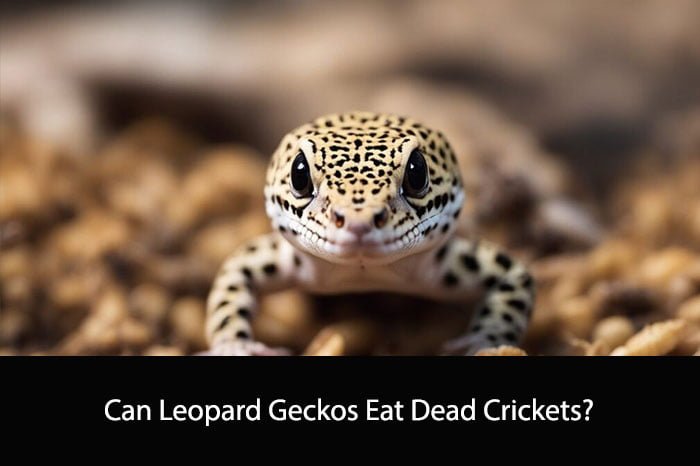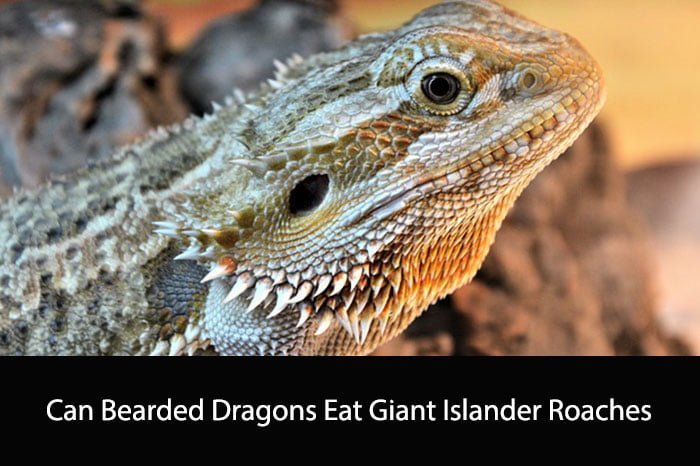Leopard geckos are fascinating pets that have captured the hearts of many reptile enthusiasts. As responsible pet owners, we want to make sure that our geckos are getting the proper nutrition they need to thrive. One common question that arises is whether leopard geckos can eat dead crickets.
Dead crickets are often more convenient than live ones because they do not move around and can be stored for longer periods of time. However, it is important to consider whether they are a suitable food source for our geckos. In this article, we will explore the question of whether leopard geckos can eat dead crickets and provide you with the information you need to make an informed decision.
Leopard Gecko Dietary Basics
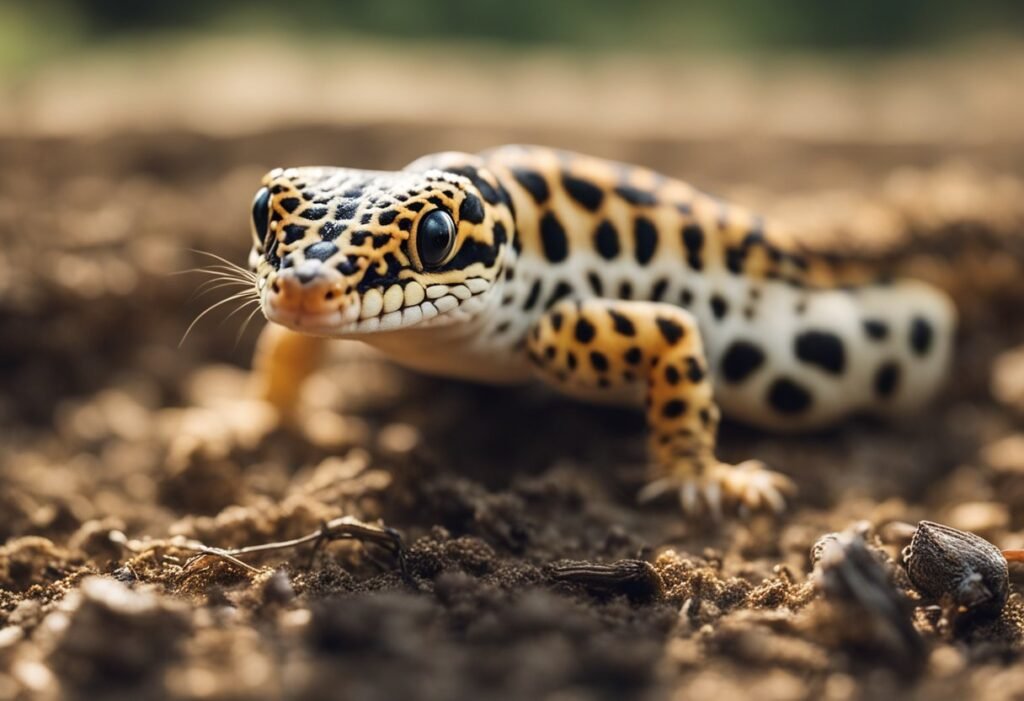
When it comes to feeding leopard geckos, it is important to understand their dietary requirements and feeding habits. In this section, we will cover the nutritional requirements and feeding frequency for leopard geckos.
Nutritional Requirements
Leopard geckos are insectivores, which means they require a diet primarily consisting of insects. The main nutritional requirements for leopard geckos include protein, fat, calcium, and vitamin D3. In order to meet these requirements, it is important to offer a variety of insects to your leopard gecko.
Some of the best insects to feed leopard geckos include crickets, mealworms, and dubia roaches. It is important to gut-load these insects with nutritious foods before feeding them to your leopard gecko. This ensures that your gecko is getting the necessary nutrients from their food.
Feeding Frequency
Leopard geckos are generally fed every other day, although the frequency may vary depending on the age and size of your gecko. Younger geckos require more frequent feedings, while adult geckos may only need to be fed once or twice a week.
It is important not to overfeed your leopard gecko, as this can lead to obesity and other health problems. A good rule of thumb is to offer an amount of insects that is roughly the same size as your gecko’s head.
In conclusion, providing a balanced diet and feeding schedule is crucial for the health and wellbeing of your leopard gecko. By following these dietary basics, you can ensure that your gecko is getting the nutrients they need to thrive.
Understanding Crickets as Food
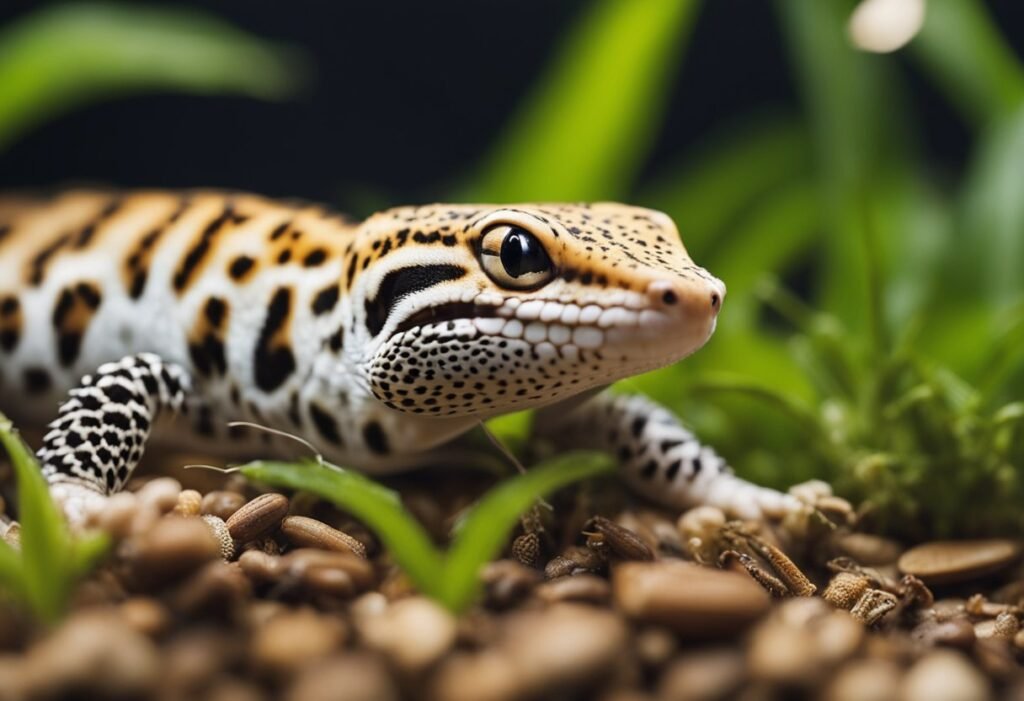
When it comes to feeding our leopard geckos, crickets are a popular choice. However, not all crickets are created equal. In this section, we will explore the benefits of live crickets and the risks of feeding dead crickets.
Benefits of Live Crickets
Live crickets are a great source of nutrition for our leopard geckos. They are high in protein, low in fat, and contain essential vitamins and minerals. In addition, the movement of live crickets can stimulate our gecko’s hunting instincts and provide mental stimulation.
Live crickets also have a longer shelf life than dead crickets, which can be important if you buy crickets in bulk. They are also less likely to carry harmful bacteria or parasites, which can be a concern with dead crickets.
Risks of Feeding Dead Crickets
While dead crickets may seem like a convenient option, they can pose some risks to our leopard geckos. Dead crickets can quickly become a breeding ground for bacteria and parasites, which can cause illness or even death in our geckos. In addition, dead crickets do not provide the same mental stimulation as live crickets, which can lead to boredom and stress in our geckos.
It is also important to note that not all dead crickets are safe to feed to our geckos. Crickets that have died from natural causes or have been killed with chemicals can be toxic to our geckos. Therefore, it is crucial to only feed our geckos crickets that have been specifically raised for reptile food and have been properly stored and handled.
In summary, while dead crickets may seem like a convenient option, live crickets provide more nutritional benefits and mental stimulation for our leopard geckos. It is important to only feed our geckos crickets that have been specifically raised for reptile food and have been properly stored and handled to avoid any potential risks.
Safety Considerations for Dead Crickets
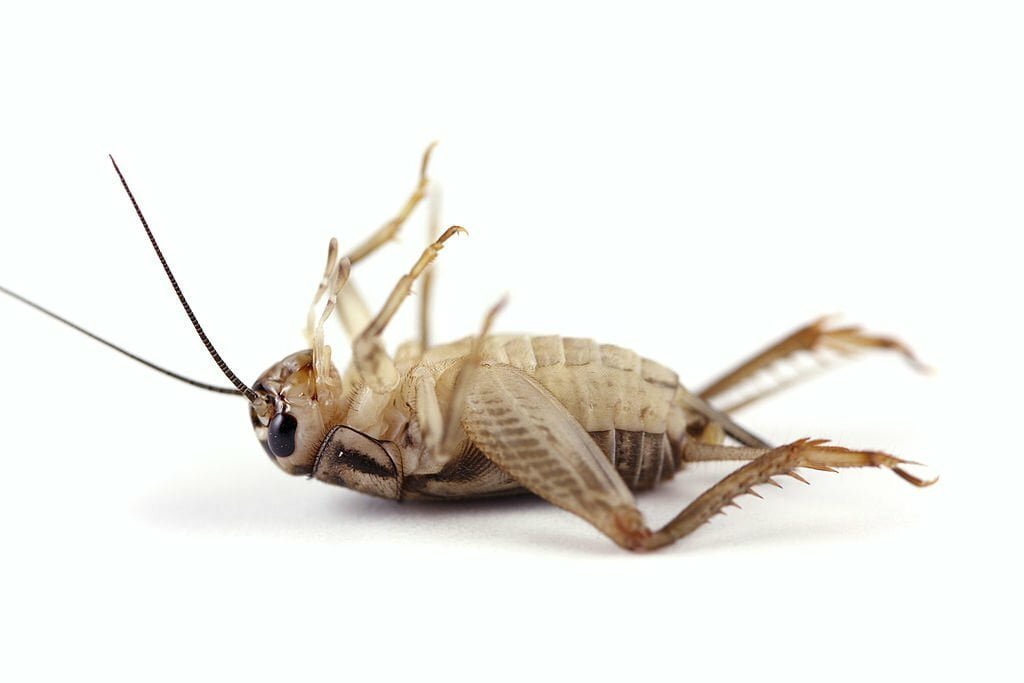
When it comes to feeding leopard geckos, it’s important to consider the safety of the food we offer them. While live crickets are a common staple in a leopard gecko’s diet, some owners may wonder if dead crickets are a safe alternative. Here are some important safety considerations to keep in mind when feeding your leopard gecko dead crickets.
Parasite and Bacteria Risks
One of the main concerns with feeding dead crickets to leopard geckos is the risk of parasites and bacteria. Dead crickets can quickly become a breeding ground for harmful organisms that can cause illness or even death in your leopard gecko. It’s important to ensure that any dead crickets you offer your gecko are fresh and free of any signs of decay.
To minimize the risk of parasite and bacteria exposure, it’s recommended to purchase dead crickets from a reputable source that specializes in reptile food. You can also consider freezing the crickets for a few hours before offering them to your gecko, as this can help kill off any harmful organisms.
Nutritional Value Loss
Another consideration when feeding dead crickets to leopard geckos is the potential loss of nutritional value. Live crickets are a great source of protein and other essential nutrients that your gecko needs to stay healthy. However, once a cricket dies, its nutritional value begins to decline rapidly.
While feeding your gecko an occasional dead cricket is unlikely to cause any harm, it’s important to ensure that the majority of their diet consists of live prey. This will help ensure that they are getting the essential nutrients they need to thrive.
In conclusion, while dead crickets can be a safe alternative to live prey in certain situations, it’s important to consider the potential risks and limitations. By keeping these safety considerations in mind, you can help ensure that your leopard gecko stays healthy and happy.
Proper Feeding Techniques
Preparing Dead Crickets
When feeding leopard geckos dead crickets, it is important to properly prepare them to ensure they are safe for consumption. We recommend purchasing pre-killed crickets from a reputable pet store or online retailer to ensure they are free of any harmful bacteria or parasites. If you choose to kill the crickets yourself, make sure to freeze them for at least 24 hours to kill any potential parasites.
Before offering the dead crickets to your leopard gecko, dust them with a calcium supplement powder to provide essential nutrients for bone health. You can also add a small amount of water to the powder to help it stick to the crickets.
Encouraging Feeding
Leopard geckos may be hesitant to eat dead crickets, as they are used to hunting live prey. To encourage feeding, we recommend using tongs to offer the crickets to your gecko, moving them in a way that mimics the movement of live prey. You can also try wiggling the cricket or tapping it on the ground to simulate movement.
It is important to monitor your gecko’s feeding habits and adjust as necessary. If they are not eating the dead crickets, you may need to switch back to live prey or try offering a different type of food. Remember to always provide fresh water and a balanced diet for your leopard gecko’s health and well-being.
Alternatives to Dead Crickets
If you’re looking for alternative food options for your leopard gecko, there are several choices that can provide the necessary nutrients and keep your pet happy and healthy. Here are some options to consider:
Live Prey Options
Live prey is the most natural and nutritious option for leopard geckos. Some popular choices include:
- Mealworms: These are a great source of protein and are easy to find at most pet stores.
- Dubia Roaches: These are a nutritious and easy-to-digest option that can be purchased online or at specialized pet stores.
- Crickets: If you prefer live prey, crickets are a good option. They can be purchased at most pet stores and can be gut-loaded with nutritious foods to increase their nutritional value.
Supplemental Foods
In addition to live prey, there are several supplemental foods that can be added to your leopard gecko’s diet to provide additional nutrients. Here are some options:
- Repashy Superfoods: These are powdered supplements that can be mixed with water and fed to your leopard gecko. They come in a variety of flavors and are a great source of vitamins and minerals.
- Calcium Powder: Calcium is an essential nutrient for leopard geckos, and adding a calcium powder supplement to their food can ensure they’re getting enough. Be sure to choose a powder that includes vitamin D3, which helps with calcium absorption.
- Fruits and Vegetables: While leopard geckos are primarily carnivorous, they can benefit from small amounts of fruits and vegetables in their diet. Some good options include carrots, squash, and apples.
Overall, there are several options available for feeding your leopard gecko. By providing a balanced diet that includes live prey and supplemental foods, you can ensure your pet is healthy and happy.
Monitoring Your Leopard Gecko’s Health
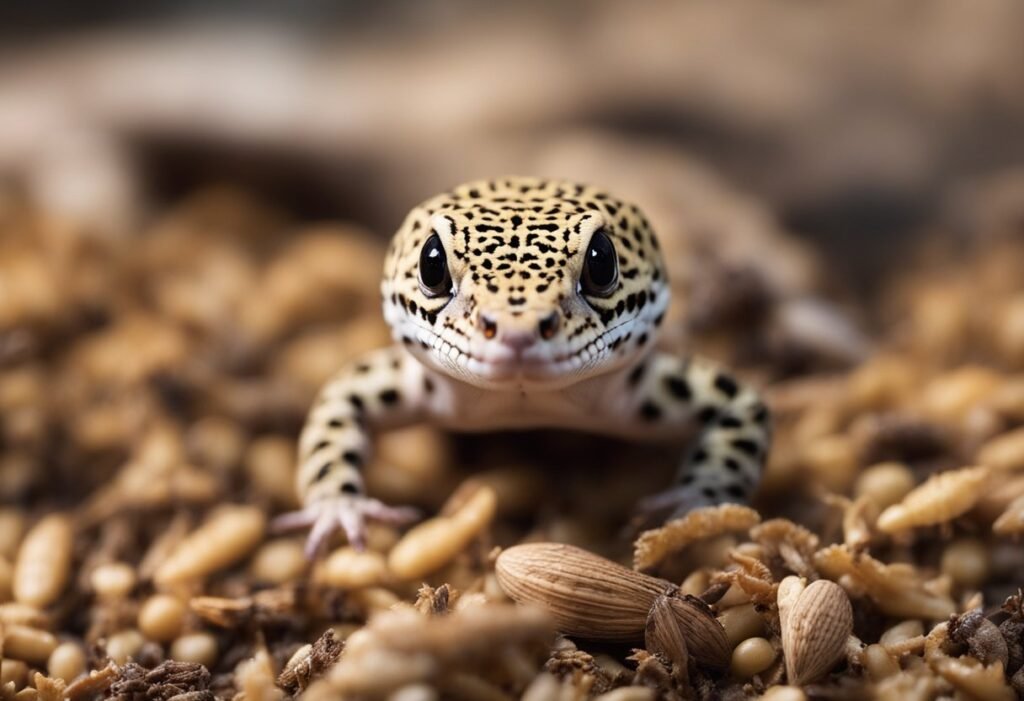
As responsible pet owners, it is important that we monitor our leopard geckos’ health regularly. This includes observing their behavior, diet, and overall physical condition. In this section, we will discuss some signs of nutritional deficiencies and behavioral changes to look out for.
Signs of Nutritional Deficiencies
Leopard geckos require a balanced diet to maintain good health. If they are not receiving the necessary nutrients, they may develop nutritional deficiencies. Some signs of nutritional deficiencies include:
- Weight loss
- Lethargy
- Weakness
- Abnormal shedding
- Stunted growth
If you notice any of these signs, it is important to consult with a veterinarian who specializes in reptiles. They can help you determine the cause of the problem and recommend appropriate treatment.
Behavioral Changes
Changes in behavior can also be an indication of health issues in leopard geckos. Some behavioral changes to look out for include:
- Loss of appetite
- Unusual aggression
- Hiding more often than usual
- Lack of interest in activity or play
- Unusual vocalizations
If you notice any of these changes, it is important to monitor your leopard gecko closely and seek veterinary care if necessary.
By monitoring your leopard gecko’s health regularly, you can ensure that they are receiving the proper care and attention they need to thrive. If you have any concerns about your leopard gecko’s health, do not hesitate to seek professional help.
Frequently Asked Questions
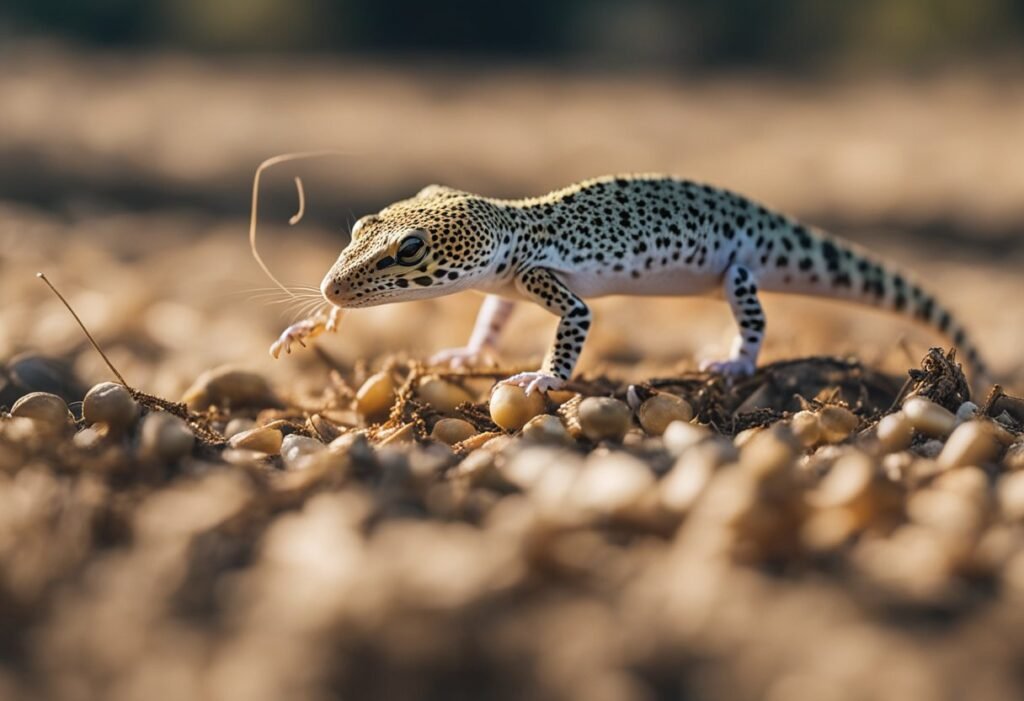
Is it safe for leopard geckos to consume non-living insects?
Leopard geckos are primarily insectivores and require live insects as a part of their diet. While they may consume non-living insects such as dead crickets, it is not recommended as it may not provide the necessary nutrition that live insects do. Additionally, consuming dead insects may increase the risk of bacterial infections for leopard geckos.
What are the dietary requirements for a healthy leopard gecko?
A balanced diet for a healthy leopard gecko should consist of a variety of live insects such as crickets, mealworms, and waxworms. It is important to ensure that the insects are gut-loaded, meaning they have been fed a nutritious diet before being fed to the leopard gecko. Calcium and vitamin supplements should also be provided to ensure proper nutrition.
How can I ensure a nutritious diet for my leopard gecko?
To ensure a nutritious diet for your leopard gecko, it is important to offer a variety of live insects and to gut-load them before feeding. Additionally, calcium and vitamin supplements should be provided as directed by a veterinarian.
Are there any risks associated with feeding leopard geckos dead prey?
Feeding leopard geckos dead prey may increase the risk of bacterial infections and may not provide the necessary nutrition that live insects do. It is best to stick to a diet of live insects to ensure a healthy and balanced diet for your leopard gecko.
What alternatives exist if my leopard gecko refuses to eat live food?
If your leopard gecko refuses to eat live food, there are several alternatives that can be offered such as canned insects, baby food, or even small pieces of cooked chicken or turkey. However, it is important to consult with a veterinarian to ensure that the alternative food options are appropriate for your leopard gecko.
How do I properly store and maintain feeder insects for my leopard gecko?
Feeder insects should be stored in a well-ventilated container with a secure lid. They should be kept at a temperature between 70-80°F and should be provided with food and water. It is important to regularly clean the container and remove any dead insects to prevent the spread of bacteria.

